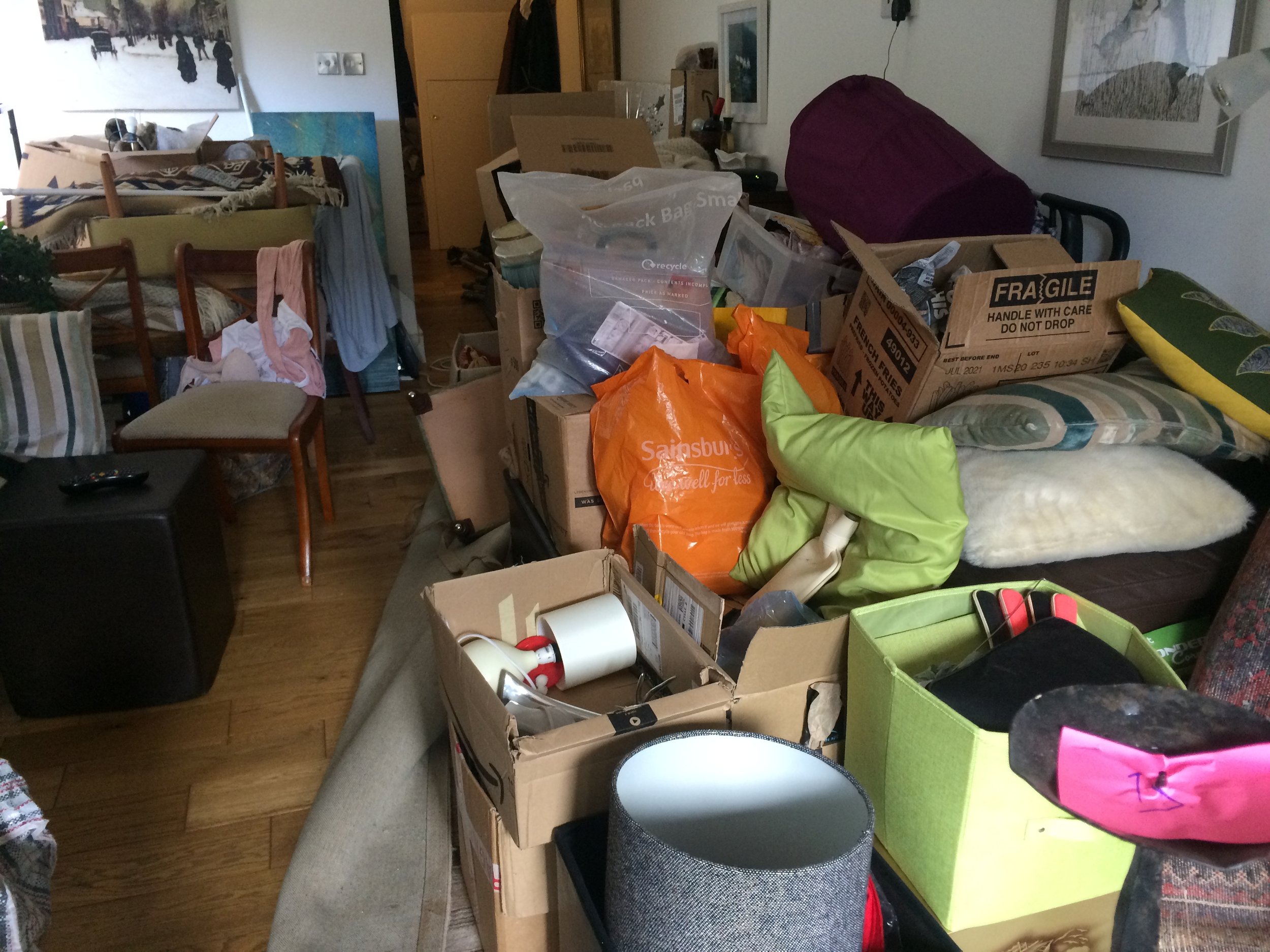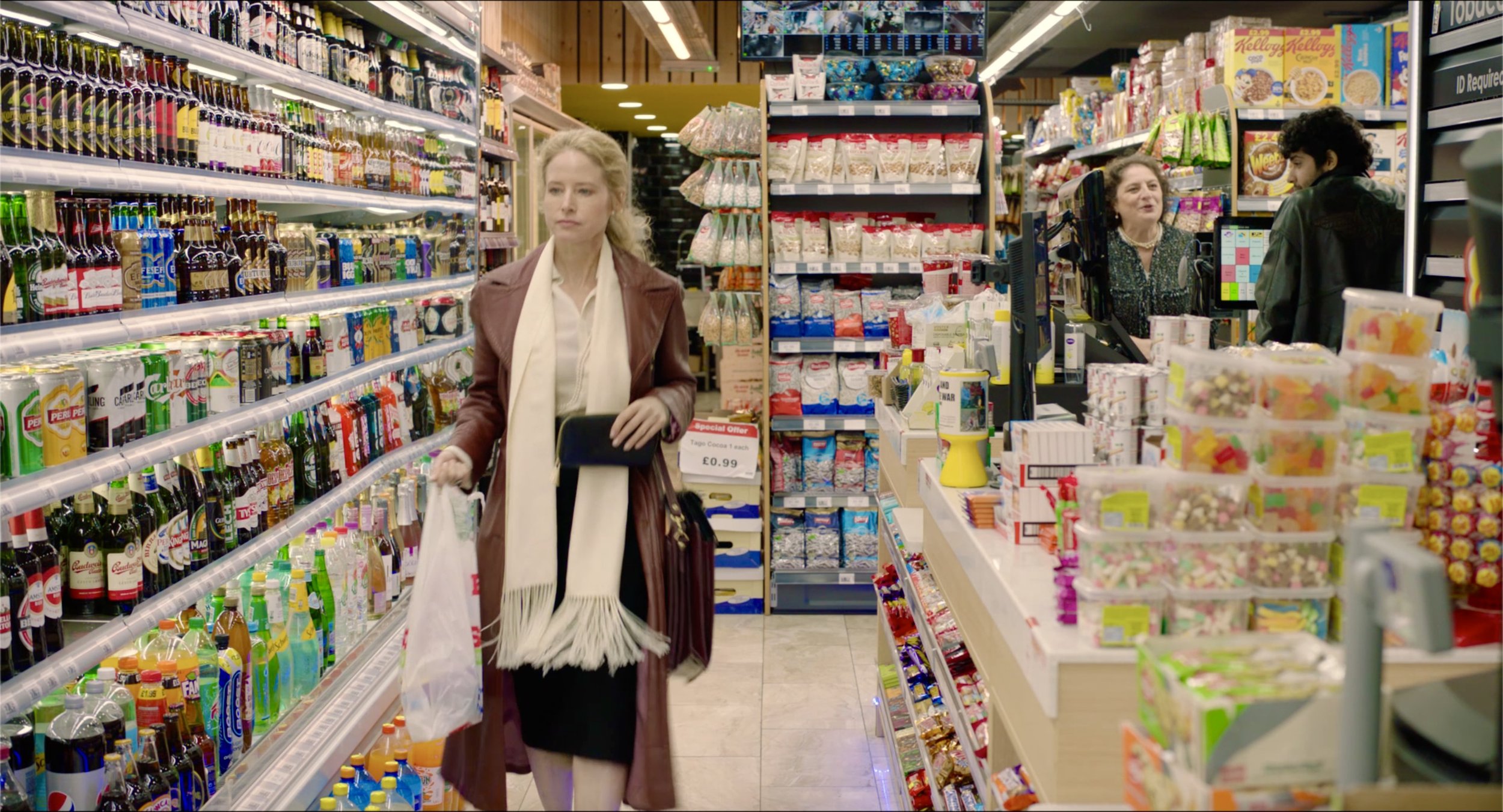‘The Yesterday’
Official Poster Festival Release after January 1, 2022 Poster Art by https://linktr.ee/Vpsudev
My role as Production Designer
“In its fullest definition, the process and application of production design renders the screenplay in visual metaphors, a colour palette, architectural and period specifics, locations, designs, and sets.
It also coordinates the costumes, makeup and hairstyles. It creates a cohesive pictorial scheme that directly informs and supports the story and its point of view” (LoBrutto, 2002) (18).
To interpet the screenplay, I had already designed each of the rooms and locations, collecting design items from charity shops including artwork, silver, dishware, cutlery and furniture months prior to covid.
My flat for the months prior to filming The Yesterday turned from a home to a holding zone for a myriad of production design items - many of which I was able to source cheaply at a local charity shop.
Matthew Button, head of Production Design at LFS, said during a workshop:
“Set design is for the context of the story – the underlying theme, metaphor, atmosphere. It is the details of dressing and props in a layout allowing for the Director’s shots. It is not self-
expression like interior design, but is the most appropriate medium for the director’s vision expressed through colour, line, pattern, repetition, architectural lines, contrast” (Button, 2018) (19).
side tables and many other items... but shops might not open due to covid. When they finally did, I was ready.
I still needed rentals: an elegant coffee table, period chairs in gold and salmon for Josephine’s posh flat, lamps for her flat and office, objets d’art as needed, plants,
The Yesterday (von Sass, 2022) film set in October of 2020 above, and rentals at the hire shop.
Shooting the actual scene below:
The Yesterday (von Sass, 2022)
I painted my own plain metal coffee table with gold. I brought shawls and pillows in the colours we needed in case we couldn’t rent chairs. I made do with what I already had and arranged substitutions from the filming venue itself as a backup plan.
When I learned we could not use the fireplace for a key ‘by the fire’ scene, we solved this by using the fireplace setting on our LED light panel, added crackling
fire sounds in post-production, and shooting the couple from the perspective of the fireplace looking to them.
This same technique of using fire crackle sound and a light source (without showing an actual fireplace), had been done in Phantom Thread (Anderson, 2017).
Phantom Thread was shot in the same Fitzroy Square location. They likely had the same fireplace restriction.
In front of the ‘fireplace’.
The Yesterday (von Sass, 2022) - #6 Fitzroy Square, London location
In the end, I was able to rent the items I needed shortly before the filming, and kept my own coffee table anyway to cut down on costs.
When the ‘The Shard’ was simply far out of my price range, I looked at options but found them cost or location prohibitive.
I needed a city view and environment to suit the established successful business woman character in my film.
I was extremely lucky in being able to access my friend’s downtown boardroom – a perfect functional boardroom for our party scene with a fantastic view.
I negotiated additionally using a portion of an adjacent recreational room for Josephine’s ‘corner office’ by clearing a ‘strip’ of student lounge furniture. I brought in an oriental carpet and set up a simple open-looking office area with a plain table, laptop, potted plants by the
windows and various higher-end embellishments like a wooden wall sculpture, Chinese Foo dog lamps, figurines and occasional table items. (We sectioned off that narrow ‘strip’ of camera to Josephine with pylons to allow the other tenants continued use while we shot.)
The result was not as posh as I would have ideally liked, but It was, perhaps, more realistic-looking as Josephine’s professional environment and that of her associates
– not too far unlike the offices in Fatal Attraction (Lyne, 1987) or A Single Man (Ford, 2009).
Fatal Attraction (Lyne, 1987)
The Yesterday (von Sass, 2022) A Single Man (Ford, 2009)
It was my goal for each location to further the theme, create atmosphere and use props and dressing as defining metaphors and symbols. In this example Josephine sits in a regal corner office atop the city. We see expensive artwork and lamps. We recognize her friendship with the psychologist through photos of the two of them on her desk. Yet she is depressed, focusing on a spider crawling by – a spider out of place from its environment, not unlike how Josephine feels.
“A production design metaphor takes an idea and translates it visually to communicate or comment upon the themes of the story. An object or an image is transformed from its common meaning and stands in for or symbolizes an aspect of the narrative, and thus adds poetic complexity to the story” (LoBrutto, 2002) (20).
The Yesterday (von Sass, 2020) is a slightly surrealist non-linear narrative revealing hidden perceptions and dreams about alienation and love, with reality transcending conventional time as told with heavy use of symbolism:
- A spider crawling outside of its normal habitat is a likewise lost Josephine;
- A balloon represents loss of childlike trust, from the ground up, floating onward ... giving meaning to Josephine looking up to the sky, or down from her sky office to a balloon to the bustling city below - finding no peace at any level from her thoughts;
The Yesterday (von Sass, 2022)
- A hairband removed by a distraught Josephine signals a change in her ways,
...then removed by the Shopkeeper, represents her willing submission to him, ...then worn by him, becoming a symbol of enduring love for her, despite his choice;
-The film noir-inspired graveyard flashbacks represent death and sadness with a headless female statue; by contrast to a female alabaster bust visible during Josephine’s happy ascent to lovemaking representing aliveness and joy
-The now green sun-speckled cemetery representing transformation from stark colourlessness to aliveness and joy;
-The ticking clock visually representing temporal urgency (11th hour) on the steeple, a knife moving around on its own like hands on a clock showing the feeling for Josephine of the passage of time, the actual ticking sound of a physical background; the clock at Josephine’s flat reminding that - like the aging protagonist in Cheri (Frears, 2009) - time is not on her side.
-The Button Suit Man (covered in luminous shell buttons) representing the ever-present opportunity for goodness - the flowers he carries beginning as pure white (overlooked by Josephine), to yellow (where she first notices him), to finally red (where she smiles at him)… corresponding with Josephine’s growing willingness to step into love;
...his buttons – symbols of the natural, shiny beauty he represents: as easy to overlook as to cherish.
The Button Suit Man with yellow roses
The Button Suit Man with red roses
I wanted colours to have meaning, whether achieved through lighting or location: red for the loving kissing scene; golden yellow for the dancing scene when the couple’s love is ignited; green for Josephine freshly in love, new things growing.
I wanted metaphors and symbols to become characters in their own right: bright candy- like colors in the convenience store with happy familiar music representing childlike enjoyment and love; and the grey dangerous city with its jarring noises, by contrast.
THE YESTERDAY BIBLIOGRAPHY
14. Mackendrick, Alexander. On Film-making. Farrar, Strauss and Giroux. New York, 2005. p. 198.
16. LFS Moodle Site. On Producing. Sixth Term. London Film School, London U.K.
18. LoBrutto, Vincent. The Filmmaker’s Guide to Production Design. Altworth Press, New York, 2002. p. 1.
19. LFS Production Design Workshop. Matthew Button lecture. London Film School, London U.K. 2018.
20. LoBrutto, Vincent. The Filmmaker’s Guide to Production Design. Altworth Press, New York, 2002. p. 25.
22. LFS Filming Workshop. Belinda Parsons lecture. London Film School, London U.K. 2018
24. Lumet, Sydney. Making Movies. Vintage Books, New York, 1996. p. 64.
26. Mackendrick, Alexander. On Film-making. Farrar, Strauss and Giroux. New York, 2005. p. 99.
27. Rodriguez, Robert. Rebel Without a Crew. Penguin Group Publishing, New York,1996. p. 209.
28. Lumet, Sydney. Making Movies. Vintage Books, New York, 1996. p. 50
THE YESTERDAY - FILMOGRAPHY
Stiller, B. & Cornfield, S. & Cohen, E. (Producers) & Stiller, B. (Director), (2008), Tropic Thunder [Feature Film], United States & Germany & United Kingdom: Red Hour Productions & DreamWorks Pictures.
von Sass, B.V. (Producer) & von Sass, B.V. (Director), (2021), The Yesterday [Short Film], U.K.: Baronesse Productions & Philosopher Fox Films & London Film School.
Sellar, J. & Anderson, P.T.& Ellison, M. & Lupi, D. (Producers) & Anderson, P.T.. (Director), (2017), Phantom Thread [Feature Film], United States: Annapurna Pictures & Ghoulardi Film Company & Perfect World Pictures.
223
Jaffe, S.R. & Lansing, S. (Producers) & Lyne, A. (Director), (1987), Fatal Attraction [Feature Film], United States: Jaffe/Lansing Productions.
Ford, T. & Miano, A. & Salerno, R. & Weitz, C. (Producers) & Ford, T. (Director), (2009), A Single Man [Feature Film], United States: Artina Films & Depth of Field & Fade to Black.
Kenwright, B. & Mount, T. (Producers) & Frears, S. (Director), (2009), Cheri [Feature Film], France & United Kingdom & Germany: UK Film Council & Pathe.
Carlson, E. & Woolley, S. & Vachon, K. (Producers) & Haynes, T. (Director), (2015), Carol [Feature Film], United States: Number9 Films & Film4 Productions & Killer Films.
Allen, J. & Vachon, C (Producers) & Haynes, T. (Director), (2002), Far from Heaven [Feature Film], United States: Consolidated Film & Industries & TF1 Cinema & Section Eight & Vulcan Productions & Killer Films.
Hunter, R. (Producer) & Sirk, D. (Director), (1955), All That Heaven Allows [Feature Film], United States: Universal-International.
Kubrick, S (Producer) & Kubrick, S. (Director), (1980), The Shining [Feature Film], United States:The Producer Circle Company & Peregrine Productions & Hawk Films.
Jurow, M. & Shepherd, R. (Producers) & Edwards, B. (Director), (1961), Breakfast at Tiffany’s [Feature Film], United States: Jurow-Shepher & Spinel Entertainment.
Marshall, A. & Puttnam, D, (Producers) & Parker, A. (Director), (1978), Midnight Express [Feature Film], United Kingdom & United States: Casablanca FilmWorks.
Berg, A.J. & Gibney, A. & Jampol, J. & LeBlond, K. (Producers & Berg, A.J. (Director), (2015), Janis: Little Girl Blue [Feature Film], United States: Disarming Films & Jigsaw Productions & Sony Music Entertainment & Artemis Rising Foundation & American Masters Pictures
Marshal, L. (Producer) & Macdonald, K. (Director), (2011), Life in a Day [Feature Film ], U.S.A.: Scott Free Productions & YouTube, Inc. & LG Group.
Cruise, T & Wagner, P. & Crowe, C. (Producers) & Crowe, C. (Director), (2001), Vanilla Sky [Feature Film], United States: Cruise/Wagner Productions & Vinyl Films & Summit Entertainment & Artisan Entertainment.
Castle, W. (Producer) & Polanski, R. (Director), (1968), Rosemary’s Baby [Feature Film], United States: William Castle Enterprises.
Lynch, D (Producer) & Lynch, D. (Director), (1977), Eraserhead [Feature Film], United States: AFI Centre for Advanced Studies.


















































































